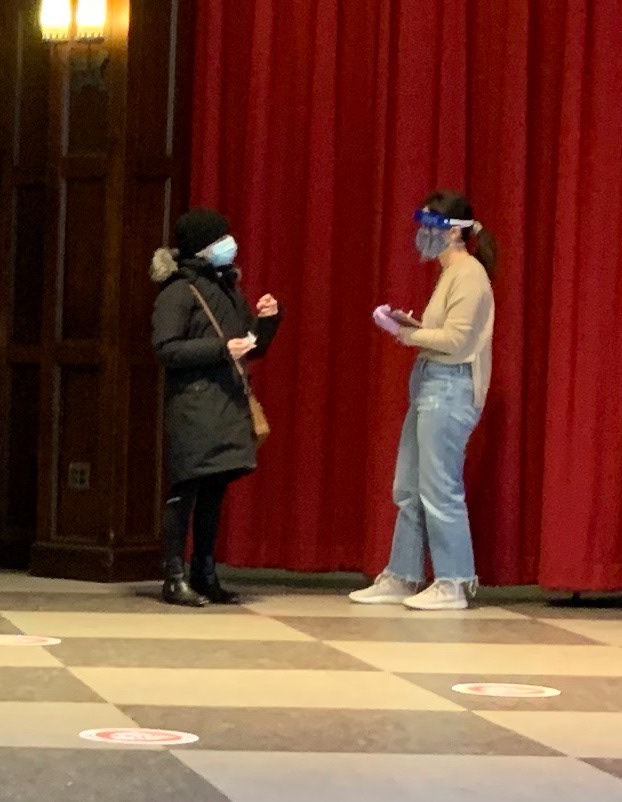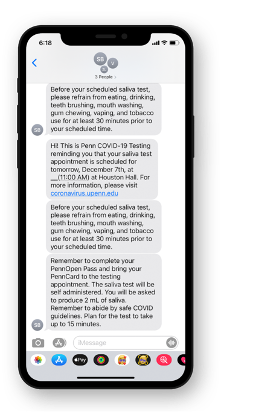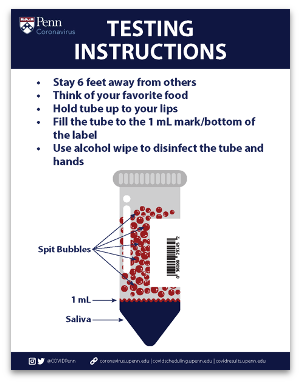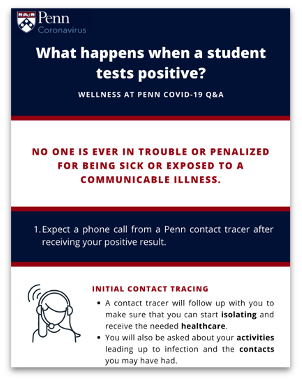IPD 551 Project 2 Final Documentation
Our team was tasked with working alongside the UPenn Provost Office and Student Health Services to understand three components of the testing experience. We investigated how to:
Enhance the experience of the saliva test
Educate students about the new testing protocol
Allow students to have easy access to the information that they need
As the administration and students prepare for the spring semester, test takers need to find motivation, gather the information necessary to get tested, and participate in the saliva testing experience. We came up with many solutions, but were only able to fully prototype, test, and gather results for 2 prototypes: redesigning Penn’s COVID-19 website and using aromatherapy during saliva testing.
University of Pennsylvania COVID Website
We wanted to understand how students were finding their info. From our survey, we found that about 48% of students rated Penn’s COVID-19 website as one of their top 3 ways to obtain and learn information. However, that percent dropped by almost half when we asked them to rate their most informative sources. This meant that students are utilizing the site, but having a hard time finding relevant information. Over the past 2 months, Penn has been positioning this website to be the central repository of all COVID-19 information on campus.
Why do students visit this website? We found 4 main reasons: schedule a test, check test results, check testing hours, and view COVID data.
Original Website
Two of the biggest issues we found were that the original site had buried links, so users had to scroll and read a lot of text in order to identify the next page they needed to go. The home page also didn’t provide that much relevant information.
Immediate Updates From the Administration
In December, the COVID task force started updating the website! We provided comments during our first meeting with the task force for a few quick-win solutions. One of them was providing “quick links” on the home page to allow students to find what they needed right away. This update was well-received in our testing and students were able to schedule a test quickly. However, there were still a few things that could be improved upon on. Scheduling an appointment was one of the most important tasks for students but they were only able to access that link from the home page. In addition, there are 3 navigation bars, making it hard for students to know where exactly they need to click to navigate to a new page.
Prototyped Website For Future Implementation
We prototyped an updated version of this site. We prioritized the most important items so our suggestions could easily be implemented quickly. We didn’t want to change the fundamental nature of the site and wanted to keep the Penn-branded feel. We updated the COVID testing links to reflect key actions that students wanted: scheduling, viewing test results, understanding what happens when there’s a positive result, and understanding what changes will happen during the spring semester. We also added new banner notifications to make announcements or key changes immediately visible on the page.
Prototyped Web Site Usability Test Results
About 70% of the students said the new site was easier to use, with a 99.2% success rate for the same tasks we asked them to complete on the original site. The time to complete each task also dropped significantly. We heard that students liked the new navigation and found it a lot easier to find and easily absorb the information they’re looking for.
COVID Saliva Tests and Aromatherapy
As Penn transitioned from nasal swab tests to saliva tests, students needed to learn a new set of rules and despite the testing center improvements, unsurprisingly, the process of dribbling saliva into a tube while standing in the middle of a room was still uncomfortable and awkward for most test takers.
Student Saliva Test-Taker Quotes
Based on our interviews and observations, we learned that test takers were uncomfortable being close to other unmasked people, they had a hard time producing saliva and the process took much longer than expected. We decided to ideate around reducing the testing time because that was the most common frustration among students.
“It's awkward to be spitting in the middle of the room with others who are unmasked”
“I have a dry mouth and it was difficult for me to salivate”
“It took forever even though I thought it would be faster”
“The test lasted much longer than I expected”
Aromatherapy
We got suggestions from people who referenced scents that act as catalysts for saliva production. This led us to explore using aromatherapy as a solution. We were directed to the Monell Chemical Senses Center. They focus on research surrounding the chemistry behind taste and smell. Dr. Dani Reed recommended several scents that would induce saliva production based on her 20 years of experience collecting over 10,000 saliva samples. Dani suggested testing lemon as a sour odorant and peach as a sweet odorant for our prototypes.
Our deployment method needed to be easily handed out and disposed of and we wanted to find a material that had the best scent delivery and preservation properties, so we tested different materials including cotton balls and other various papers, determining that poster board was the cheapest and best option. We also decided that the lemon scent, as opposed to the peach scent, promoted more saliva production which was in line with a study that the Monell Center sent to us.
Control vs. Experiment
We started our aromatherapy test by first collecting our control data. Giving credit to our client, the testing center was transformed to improve efficiency. There are now 36 dots for test takers to stand on. The space paired with the scheduling system made the center less crowded, allowing the staff members to give personalized instruction, answer questions and help test takers with kind encouragement. During the control, we timed 32 test takers and found that the average time was 4:10 and the median time was 4:08. We also interviewed 20 students as they exited the site.
The next day we returned to the test site to collect our data. There was an increase in first time test takers and a few outliers who took longer than 11 minutes, which may have resulted in longer average testing times. Despite this, we still found that there was a reduction in the time that it took students to produce a saliva sample while using the lemon scent strips. This led to an average of 4:05, but the median time was reduced by almost 21% to 3:16. Over our experiment days, we conducted 38 interviews and observed 55 people. While this quantitative data is supportive of our goal, the qualitative comments from interviews were most insightful.
Aromatherapy Results
“I liked the lemon scent because it made me feel that the room is clean”
“I used to think about sour things but these strips are better”
“It seemed to go MUCH faster. I loved it! I would like to have it as an option moving forward!”
“I really liked the scent strip from my last test, do you have any more of them?”
After talking to the staff, we learned there was no disruption in their workflow in order to distribute the scent strips, which makes them a viable option. Participants believed that the lemon scent made the room feel safer and more clean and they wanted to continue to use them because it helped them produce saliva faster. We even had a returning test taker ask for the scent strips during one of their subsequent visits. We found that about 70% of students who used the strips said that it helped them generate saliva, and their perceived difficulty of performing the test and the duration of test decreased.


Other Solutions
Besides redesigning the covid website and implementing aromatherapy at testing sites, we worked on 3 other solutions addressing the information gathering problems. These would work alongside the new website to provide students needed information. We encountered testing constraints, but these prototypes can still be used by our client in other ways.
The first solution consists of two text reminders. One being sent a day in advance to help student confirm their appointment and another an hour before their scheduled test to prepare them for saliva test specific requirements such as no eating or drinking 30 min before the test. Due to technology, privacy and consent constraints, we weren’t able to test this prototype.
We created signs to help students before and during their saliva tests. Due to the change of the testing site layout and since the new requirement of appointments eliminated the waiting line, we weren’t able test these as planned. However, these signs are already implements as prints displayed at the check in table in Houston Hall.
We designed 2 infographics to explain what happens if a student were to test positive or become exposed to COVID to address some misconceptions. Tests were run on 9 infrequent testers and the results weren’t statistically significant. However, students did prefer the infographics over the Trace and Isolate FAQ webpage.




Lessons Learned
COIVD is a fast evolving issue. From the start of our project to the end, we had to adapt many times based on the changes that were implemented across campus, testing site changes and the fundamental evolution of the virus itself. Being flexible and patient in a constantly changing environment is a quality that we needed for this project. In response to the devastating effects the virus has had on our community, all of the experts, students and faculty that we reached out to were very responsive, generous and helpful sharing their collective knowledge with us. The reinforcement of reaching out to people who may be able to help for advice has been apparent during this project. Having a bias toward action in terms of talking to interesting people has been something that I learned years ago. This project confirmed the positive outcome that those reach out communications can have.
Projects become easier and more fun when you work with a great team. Most of the projects that I've worked on have been solo projects, making it hard to obtain constructive feedback. Working with Rachel, Vashvi and Zining was a pleasure. I enjoyed being part of such a positive, intelligent and creative group. Our ideas and final deliverables became better because of the diverse expertise of each group member. Friendships and relationships are powerful and are something I value significantly. I was happy to build great friendships with such a great group of women.